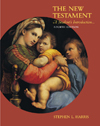 |  The New Testament, 4/e Stephen Harris,
California State University - Sacramento
Continuing the Pauline Tradition: 2 Thessalonians, Colossians, Ephesians, the Pastoral Epistles, 1 Clement, and the Epistle of Barnabas
Outline
I. Key topics/themes - Letters written in Paul's name after his death
- 2 Thessalonians: reinterpretation of Pauline eschatology
- Colossians: Jesus Christ as cosmic power living within the believer
- Ephesians: Jew and Gentile united in one church
- Pastorals: warnings against heresy; importance of adhering to established church tradition
- 1 Clement and Barnabas: methods of church organization; interpreting the Hebrew Bible
|
|



 2002 McGraw-Hill Higher Education
2002 McGraw-Hill Higher Education